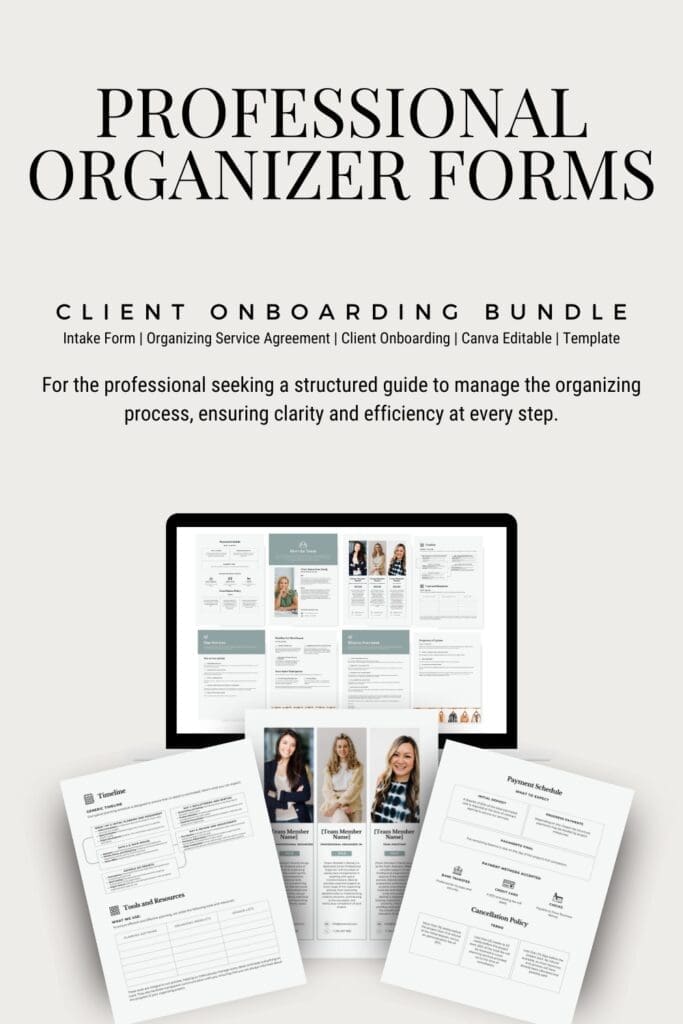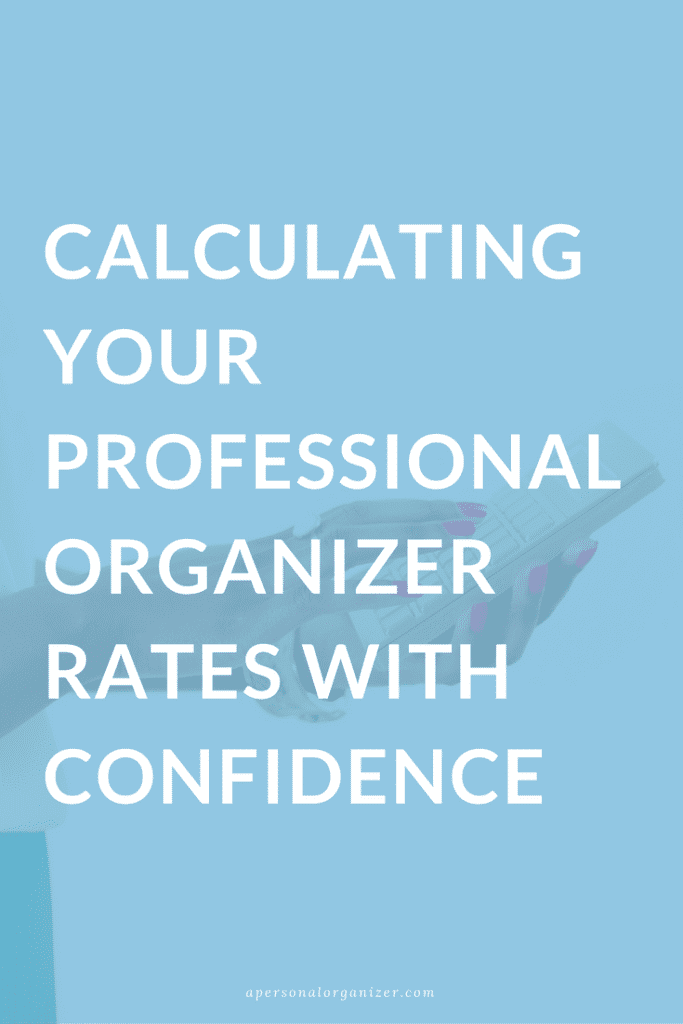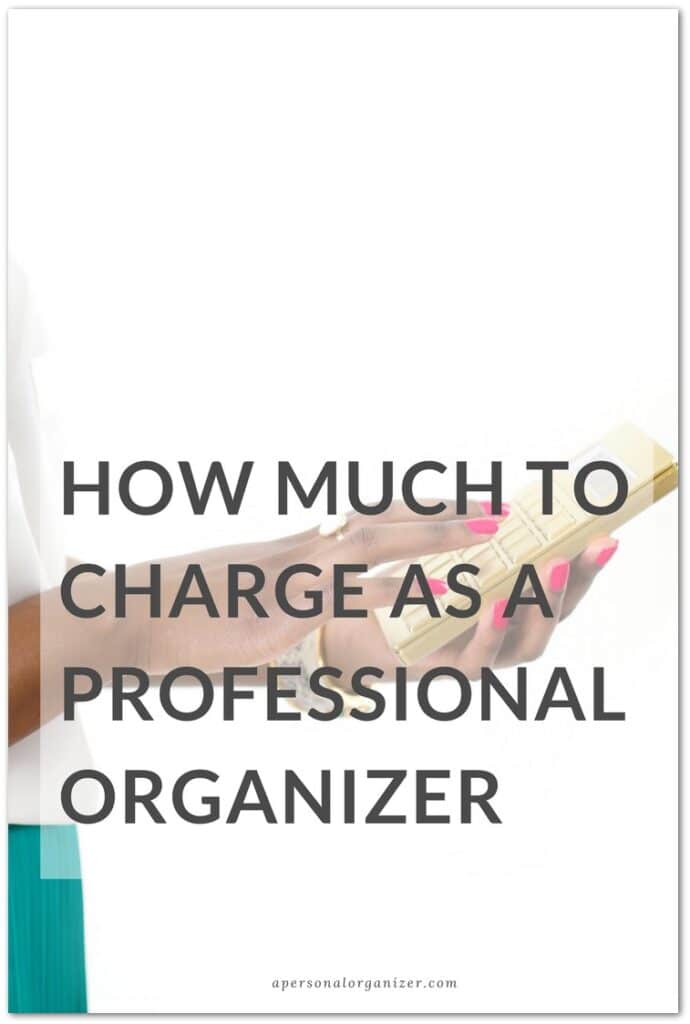This post may contain affiliate links for your convenience. As an Amazon Associate, A Personal Organizer, LLC earns from qualifying purchases.
How Much Should I Charge as a Professional Organizer?
One of the most challenging questions to answer when starting as a professional organizer is: How much should I charge? How do I calculate my professional organizing rates? How do I make a budget? How do I create price packages?
First, there is no magic formula to calculate our fees. Depending on your education or area of professional expertise, you may never have been taught to calculate prices for a product or service.
Let’s examine other factors that will affect your ability to calculate your price.

1. What value do you bring?
We may lack understanding of the value we provide, and that will impact our ability to set our prices.
We may know our skills are valuable, but we don’t know how to communicate them.
For example, organized kitchens are both practical and efficient in optimizing household work. Maintaining well-organized fridges and pantries can lead to significant savings in both time and money.
Well-planned menus reduce spending on your clients’ groceries. They can also provide healthier, homemade meals and allow them to have dinner with their family. All these improvements have a positive impact on their mental, emotional, and physical health.
However, due to our inexperience, we often struggle to effectively communicate all these benefits when selling our services.
As new organizers with limited organizing experience, we haven’t had the chance to internalize the results we provide and create a vocabulary that will effectively convey our message.
2. What about my business expenses?
Another aspect that influences our ability to calculate our fees is related to the cost we incur in creating and operating our company.
As a “newbie,” we come into this industry without any idea of how much is needed to start and develop our business.
So, how much do I charge as a personal organizer?
A commonly used exercise by business coaches is to use a formula based on “how much you want to earn” and then work it backward.
I think this is OK for your first year in business, but to stay on solid ground, you should move to a more detailed way of calculating your fees as a professional organizer after your first year of operation.
Below are two ways to get to your number.
3. Professional Organizer Rate – Exercise 1
The simplest way to calculate your price is to do it with the end number in mind.
This method of calculating fees is the most frequently used by business coaches, and it can be pretty helpful when we are in the early stages of organizing our business. We still don’t have a clear picture of our expenses.
So, let’s do a calculation. You should add an estimate for expenses and taxes.
Step 1: Determine your desired annual income.
Let’s say you want to make $ 60,000 / year.
Step 2: Determine how many weeks a year you want / can work.
Let’s say you want to take four weeks of vacation per year and will work 48 weeks a year.
Step 3: Divide the total $ by the number of weeks.
Let’s divide $45,000 by 48, which is the number of weeks you want or can work, and you get $937 / week.
Step 4: Determine how many hours a week you want / can work.
To get an income of $ 937 / week, working:
- 10 hours a week, you would have to charge $ 94.00 for an hour
- 20 hours a week, you would have to charge $ 47.00 for an hour
- 30 hours a week, you would have to charge $ 31.00 for an hour
- 40 hours a week you would have to charge $ 23.00 for an hour
Knowing these numbers also helps you understand how many clients you need to enroll per month.
This simple exercise helps you estimate how much you should charge based on your desired earnings. And of course, remember to consider your taxes when calculating these numbers.
However, once your business starts rolling, you’ll have costs associated with it, making it very important to keep a spreadsheet that includes all operating expenses. After 12 months, you’ll have a clear picture of how much you spend to run your business.
I recommend that once you commit to your professional organizing business, you invest in and use an accounting tool like FreshBooks or QuickBooks.
Pro Organizing Planners
Professional Organizer Forms
Transform your Organizer Business with our comprehensive Professional Organizing templates! Designed specifically for Professional Organizers, these tools will help you streamline your client management and improve your business operations. Our customizable Organizer Contract, Client Intake Form, and Client Agreement ensure clear communication and professionalism with every project.
4. Professional Organizer Rate – Exercise 2
Calculating your Professional Organizing Rate with data.
After running your business for some time, you’ll know what your costs are, and you can use this calculation to set your professional organizing rates:
1. Create a spreadsheet and enter all the expenses you incur to run your business. See a list of suggestions below.
2. In a second column to the right, enter how much you paid for each service. Add up all these costs to create a monthly total.
3. Divide this total by the number of days worked – if you work 25 days a month, divide this monthly total by 25.
4. The result (the monthly total divided by the number of working days) is the cost of a day’s work. This value is the minimum you need to “charge” to cover your expenses, and any amount above that number is your profit.
An essential benefit of knowing this number is that it serves as a baseline when establishing your fees for other services you may offer, which require different levels of effort and/or engagement on your part.
To help you create your spreadsheet, below are common everyday expenses in a Professional Organizer Business. You can also download a handy spreadsheet to help you get started now!
Professional Organizing Business – Common Expenses:
- Taxes – will depend on the legal structure that you use for your business.
- Business License – check your city’s website.
- Accountant
- Legal advice
- Financial expenses
- Bank charges
- Fees on sales online
- Credit card processing fees
- Insurance for property (equipment) and business (required here in the US)
- Professional associations (NAPO, ICD, ANPOP)
- Training – includes books, classes, lectures, workshops, courses.
- Coaching
- Annual Conference
- Auto
- Taxes
- Gas
- Car Maintenance
- Parking
- Tolls
- Fines
- Office – if you separate your office from your home.
- Energy
- Phone – dedicated line for your business.
- Internet
- Software – purchases and upgrades.
- Marketing
- materials
- pictures
- graphic design
- social media management platforms
- two options: pay someone or “do it yourself,” as I did.
- Website
- Two possibilities: pay someone or “do it yourself,” as I did.
- Maintenance – unless you are willing to research and learn how to install and monitor the security and integrity of your site, it’s worth paying someone.
- hosting
- domain
- Stationery / Office supplies
- used in projects with clients
- used by you
I hope this information will help you understand and calculate your professional organizing rates. Being a successful organizer means having well-managed finances.
Read More Pro Organizing Business
SEE ALL >>
Professional organizing
Professional Organizer Forms
Transform your Organizer Business with our comprehensive Professional Organizing templates! Designed specifically for Professional Organizers, these tools will help you streamline your client management and improve your business operations. Our customizable Organizer Contract, Client Intake Form, and Client Agreement ensure clear communication and professionalism with every project.
Take your business to the next level with these essential tools for Professional Organizing success!


















